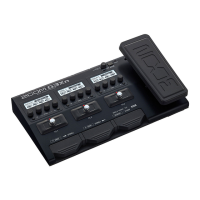
Do you have a question about the Zoom G3Xn and is the answer not in the manual?
| Rhythm Patterns | 68 |
|---|---|
| Display | LCD |
| Footswitches | 3 |
| Expression Pedal | Yes |
| Sampling Frequency | 44.1 kHz |
| A/D Conversion | 24-bit |
| D/A Conversion | 24-bit |
| Headphones | 1 x 1/4" |
| MIDI | No |
| Type | Multi-effects processor |
| Effects | 70 |
| Patch Memory | 150 |
| Looper | Up to 80 seconds |
| Inputs | 1 x 1/4" (guitar), 1 x XLR (mic) |
| Outputs | 2 x 1/4" |
| USB | 1 x Type B |
| Power | 9V DC power supply (included) |
| Effects Types | Distortion, Modulation, Delay, Reverb |
| Frequency Response | 20Hz - 20kHz |
| Power Source | AC adapter |
| Dimensions | 181mm x 318mm x 64mm |
| Simultaneous Effects | Up to 7 |
| Weight | 1.84 kg |
Summarizes symbols and warnings for accident prevention.
Covers interference, cleaning, malfunction, and copyrights.
Highlights the advanced user interface with three displays for easy parameter checking.
Describes studio-quality sound via amp/cabinet emulations and impulse responses.
Explains how to download new effects and patches using ZOOM software.
Defines a patch as a stored set of effect parameters and ON/OFF states.
Defines a bank as a set of three patches.
Defines a unit as a combination of display, knobs, and footswitch.
Defines a large effect as an effect using multiple units.
Identifies components and controls on the front of the device.
Identifies connectors and ports on the rear of the device.
Step-by-step guide to powering the unit on correctly.
Explains the auto-off feature for power saving.
Details how displays appear and function in STOMP mode.
Details how displays appear and function in MEMORY mode.
Explains how to view effects within a selected patch.
Instructions on how to enable or disable individual effects.
Guide to choosing different types of effects for a unit.
How to navigate and select effect categories.
Details how to fine-tune effect parameters using knobs.
Instructions for navigating through effect parameter displays.
Steps to add new effects to a patch chain.
How to choose the position for a new effect in the chain.
How to choose the specific type of effect to add.
How to choose which effect to remove from the chain.
Steps to reorder effects within a chain.
Guidance on using amp effects with cabinet effects for optimal sound.
How to choose between different saved patches using footswitches.
How to navigate through groups of patches (banks).
Steps to access the mode for editing patch-specific settings.
How to set the volume level for individual patches.
How to edit the names of saved patches using character selection.
Instructions on how to save current patch settings to memory.
Guide on exchanging the positions of two patches.
Confirmation step for swapping patches.
Accessing the master volume setting via the menu.
Steps to access the main settings menu.
Configuration for the patch preselect feature.
How to enable or disable the automatic power-off function.
Configuration for automatic saving of parameters.
Accessing display contrast settings via the menu.
Steps to turn on the instrument tuning function.
Guide on how to tune the instrument using the device.
Steps to exit the tuner screen.
Accessing the menu for tuner configuration.
Adjusting the reference pitch for tuning.
Selecting different tuning modes (e.g., chromatic, open tunings).
Instructions for setting up drop tuning.
How to choose a rhythm pattern.
Instructions to start rhythm playback.
How to stop the rhythm playback.
Choosing specific rhythm patterns from the list.
Setting the beats per minute for rhythms.
Controlling the playback volume of rhythms.
Choosing a looper type (1-unit or 2-unit).
Steps to start recording a loop phrase.
Adding layers to an existing loop.
How to stop the playback of a recorded loop.
Instructions to remove recorded loop phrases.
Configuring the duration for loop recording.
Enabling/disabling the UNDO feature for loop overdubs.
Explains how to undo/redo overdubbing or deleted phrases.
Options for loop termination (Stop, Finish, Fade Out).
Controlling the output volume of the looper.
Setup for an external expression pedal.
Assigning pedal effects and enabling the pedal.
Specifics on using the built-in expression pedal.
Choosing which effect the pedal controls.
Adjusting the pedal's response sensitivity.
Modifying the physical resistance of the pedal.
Activating the tap tempo feature for synchronization.
How to set the tempo by tapping.
Exiting the tap tempo adjustment screen.
Steps to reset all settings and patches to factory defaults.
How to view the current firmware version installed.
Procedure to download and install the latest firmware.
Solutions for audio output issues.
Troubleshooting steps for unwanted audio noise.
Addresses issues with effects not functioning correctly.
Tips for resolving expression pedal issues.
Lists the total number of available effect types.
Indicates maximum effects usable at once.
Specifies capacity for saving custom patches.
Technical detail about the sampling rate.
Technical specification for analog-to-digital conversion.
Technical specification for digital-to-analog conversion.
Technical detail on internal signal processing bit depth.
Technical data on audio frequency response.
Details about the device's display type and resolution.
Specifications for the main instrument input jack.
Specifications for the auxiliary audio input.
Specifications for the main audio output.
Specifications for combined line/headphone output.
Technical measurement of input noise.
Technical measurement of residual noise level.
Details about the external control input.
Power requirements and adapter specifications.
Physical measurements of the device.
USB connectivity type.
Device weight specifications.
Compatible optional accessories.
